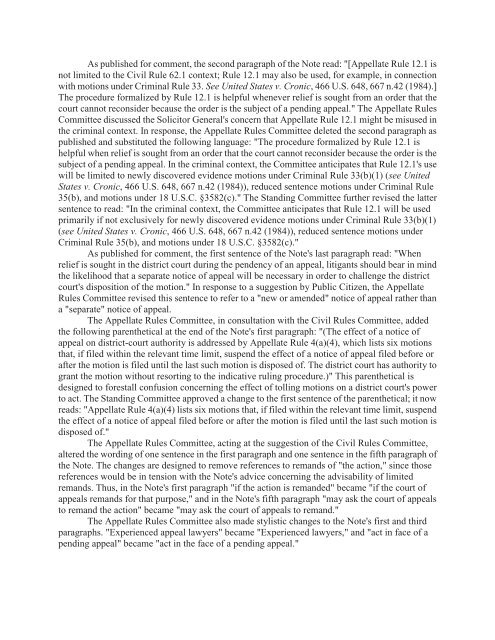Federal Rules of Appellate Procedure 2014-2015, 2014a
Federal Rules of Appellate Procedure 2014-2015, 2014a
Federal Rules of Appellate Procedure 2014-2015, 2014a
You also want an ePaper? Increase the reach of your titles
YUMPU automatically turns print PDFs into web optimized ePapers that Google loves.
As published for comment, the second paragraph <strong>of</strong> the Note read: "[<strong>Appellate</strong> Rule 12.1 is<br />
not limited to the Civil Rule 62.1 context; Rule 12.1 may also be used, for example, in connection<br />
with motions under Criminal Rule 33. See United States v. Cronic, 466 U.S. 648, 667 n.42 (1984).]<br />
The procedure formalized by Rule 12.1 is helpful whenever relief is sought from an order that the<br />
court cannot reconsider because the order is the subject <strong>of</strong> a pending appeal." The <strong>Appellate</strong> <strong>Rules</strong><br />
Committee discussed the Solicitor General's concern that <strong>Appellate</strong> Rule 12.1 might be misused in<br />
the criminal context. In response, the <strong>Appellate</strong> <strong>Rules</strong> Committee deleted the second paragraph as<br />
published and substituted the following language: "The procedure formalized by Rule 12.1 is<br />
helpful when relief is sought from an order that the court cannot reconsider because the order is the<br />
subject <strong>of</strong> a pending appeal. In the criminal context, the Committee anticipates that Rule 12.1's use<br />
will be limited to newly discovered evidence motions under Criminal Rule 33(b)(1) (see United<br />
States v. Cronic, 466 U.S. 648, 667 n.42 (1984)), reduced sentence motions under Criminal Rule<br />
35(b), and motions under 18 U.S.C. §3582(c)." The Standing Committee further revised the latter<br />
sentence to read: "In the criminal context, the Committee anticipates that Rule 12.1 will be used<br />
primarily if not exclusively for newly discovered evidence motions under Criminal Rule 33(b)(1)<br />
(see United States v. Cronic, 466 U.S. 648, 667 n.42 (1984)), reduced sentence motions under<br />
Criminal Rule 35(b), and motions under 18 U.S.C. §3582(c)."<br />
As published for comment, the first sentence <strong>of</strong> the Note's last paragraph read: "When<br />
relief is sought in the district court during the pendency <strong>of</strong> an appeal, litigants should bear in mind<br />
the likelihood that a separate notice <strong>of</strong> appeal will be necessary in order to challenge the district<br />
court's disposition <strong>of</strong> the motion." In response to a suggestion by Public Citizen, the <strong>Appellate</strong><br />
<strong>Rules</strong> Committee revised this sentence to refer to a "new or amended" notice <strong>of</strong> appeal rather than<br />
a "separate" notice <strong>of</strong> appeal.<br />
The <strong>Appellate</strong> <strong>Rules</strong> Committee, in consultation with the Civil <strong>Rules</strong> Committee, added<br />
the following parenthetical at the end <strong>of</strong> the Note's first paragraph: "(The effect <strong>of</strong> a notice <strong>of</strong><br />
appeal on district-court authority is addressed by <strong>Appellate</strong> Rule 4(a)(4), which lists six motions<br />
that, if filed within the relevant time limit, suspend the effect <strong>of</strong> a notice <strong>of</strong> appeal filed before or<br />
after the motion is filed until the last such motion is disposed <strong>of</strong>. The district court has authority to<br />
grant the motion without resorting to the indicative ruling procedure.)" This parenthetical is<br />
designed to forestall confusion concerning the effect <strong>of</strong> tolling motions on a district court's power<br />
to act. The Standing Committee approved a change to the first sentence <strong>of</strong> the parenthetical; it now<br />
reads: "<strong>Appellate</strong> Rule 4(a)(4) lists six motions that, if filed within the relevant time limit, suspend<br />
the effect <strong>of</strong> a notice <strong>of</strong> appeal filed before or after the motion is filed until the last such motion is<br />
disposed <strong>of</strong>."<br />
The <strong>Appellate</strong> <strong>Rules</strong> Committee, acting at the suggestion <strong>of</strong> the Civil <strong>Rules</strong> Committee,<br />
altered the wording <strong>of</strong> one sentence in the first paragraph and one sentence in the fifth paragraph <strong>of</strong><br />
the Note. The changes are designed to remove references to remands <strong>of</strong> "the action," since those<br />
references would be in tension with the Note's advice concerning the advisability <strong>of</strong> limited<br />
remands. Thus, in the Note's first paragraph "if the action is remanded" became "if the court <strong>of</strong><br />
appeals remands for that purpose," and in the Note's fifth paragraph "may ask the court <strong>of</strong> appeals<br />
to remand the action" became "may ask the court <strong>of</strong> appeals to remand."<br />
The <strong>Appellate</strong> <strong>Rules</strong> Committee also made stylistic changes to the Note's first and third<br />
paragraphs. "Experienced appeal lawyers" became "Experienced lawyers," and "act in face <strong>of</strong> a<br />
pending appeal" became "act in the face <strong>of</strong> a pending appeal."


















